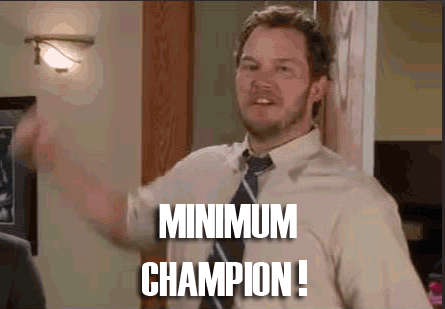
cc licensed ( BY NC SD ) flickr photo shared by Pete Prodoehl
I truly love the evolution and use of the ds106 assignment collection – we have almost 100 assignments to choose from each in the Visual and Design sections, all of them created by ds106 participants, and even rated by them for difficulty.
A downside is, well, some of them lend themselves to be done rather easily. Some of them, like What People Think I Do or Zombify Yourself are done simply by going to a web site and clicking a few buttons. You can satisfy the minimum of the requirements in an expedient fashion.
Or we have seen many ways people have used a wide range of graphic editing tools to complete the Color Splash Assignment versus other students who complete the assignment using an iPhone app.
Martha and I wonder how to deal with this not only on an assessment level, but as a concern over what the students are learning. I worry that in their zeal to accomplish the requirements of the assignments, that our students get too focused on the easiest route to the end. That they are just wanting to do enough to get the points.
So I find myself wondering what to do about this. We specifically do not prescribe how students create their works, this is so they can use software they have or find or discover. Yet, what I would like them to learn are the underlying principles of designing a good graphic, the use of layers, effects, control over transparency, using text controls, etc that you only get to in tools like PhotoShop, GIMP, and even on the web in some in Aviary.
Just as much as we want students to take control of their expression and presence on the web, we’d like them to leave with more creative schools than how to crank out a graphic in an app or a pre-rigged web site.
One way I can balance this is to have a richer expectation of creating the narrative around the works they create. Oka, you make a zombie image of your roommate, your cat, whomever in 5 minutes on Zombify, then you better do a lot more writing in your blog post- give me some story that this is part. I get really tired of commenting on a number of students who merely post an image as an assignment done with two sentences of explanation, when we have made it clear that there are criteria that need to me included – the idea, inspiration, story behind the story, and how it was created. I’m docking already for these deficiencies, but I am pondering how I can balance the expectation for doing more than using one-off apps.
It’s not to say you cant be creative with them, but there’s not much real learning gained by doing things the easiest way. So my students are going to have to show me a ton more creative snuff if they are going to slap out graphics with a web or mobile app.
Thoughts? Ideas? Does anyone even comment anymore? Bueller?
Do you see that photo at the top of this post? Scroll up and look at it again.
Pretty much any monkey or cicada could click a button. That is as complex as Facebook Liking. It is being a Minimum Champion:

gif magic by Giulia Forsythe
That is not what ds106 is about.
ds106 is about doing things like re-rigging that stupid head button to make more wild noises, but opening it up, re-wiring the circuits, adding a variable resistor, circuit bending.
The world has enough mooc-headed button pushers- ds106 is about helping people learn how to bend the circuits.
Where do you want to be?

I want to be here:
https://dl.dropbox.com/u/2251996/Getting%20Bent.mp3
you sir are there way ahead of the pack!
I have a plastic guitar and talking infant toy waiting for me in Welland to do some bending. Got tips for basic beginner? What should I start with? I had a session with @noiseprofessor so I have a gist of the game
Well, Shee-it,Capn, and here I finally thought I could make one of those stupid giffy thingies usin a Gif My Zombie app.
i hate the carrot stick grading system, but we’re stuck with it, so you gotta just make a really clear stick right from th beginning. This is the carrot end–see it? This is the stick end, the size and the shape of a screw. Apply each as needed.
Students are uber realists; our level of cynicism needs to outweigh theirs. However, we have in the other pocket the full weight of our utter belief in the power of creativity for those students mature enough to lift their heads out of the black and white world to see, be, and create in living color.
For them, not just carrots, but oysters on the half shell.
Some butts gotta be kicked.
That’s the Cider House Rules.
Make ’em post an “in progress” image/thing along with the finished work. Makes for better blogging too, and gives you a range of example for tutorials.
That is one I like. I have seen a few students post the stages of their work, doing screen caps or exports of the different stages.
And for Sandy’s point, yes, I think we need to adjust our specs.
Actually an idea that has come out of my visit with Barbara Ganley, what she has done with her writing students in the past, is to have them co-develop the criteria for “good work” so it becomes their rubric, not mine.
Actually, that is something I do all the time, and I am reminded to do it once again. Like on Monday! As an entire class, I have them brainstorm the categories of evaluation (like content, organization, style, mechanics, etc.). Then I break them up into groups. Each group takes one category and makes two lists: what does an A look like? What does a C look like?
If we’re in a computer classroom, I have them put the lists on one Google Doc.
I go to rubistar.com and create a rubric based on their criteria (sometimes I shorten or tweak the wording).
I download the resulting rubric and either make copies of it or post a central Google Doc. The groups review their section first and either sign off on it or ask for refinements. The rubric is projected, and the groups one by one discuss their section.
Discussion.
Private vote to adopt the rubric.
Then I ask them to copy and paste the rubric into the bottom of an assignment being posted on a Google Doc and to evaluate their own work. I look at their work, their evaluation, add my reality check and grade as needed.
This is good pedagogy imho.
Please post if you go this route. I’d like to hear your continued thinking on this important subject.